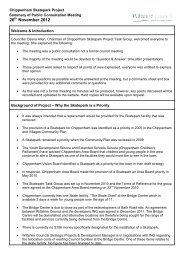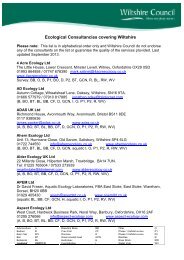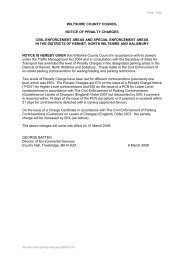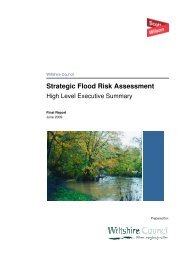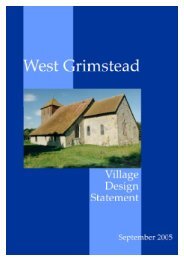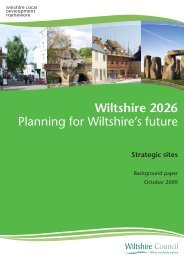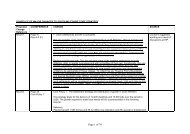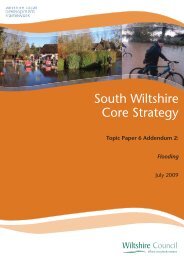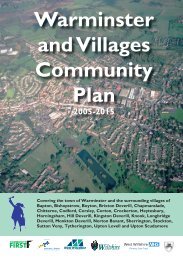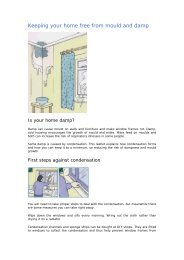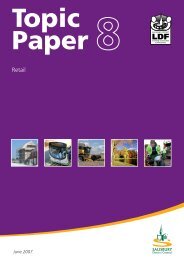Durrington CAA_doc.qxp - Wiltshire Council
Durrington CAA_doc.qxp - Wiltshire Council
Durrington CAA_doc.qxp - Wiltshire Council
- No tags were found...
You also want an ePaper? Increase the reach of your titles
YUMPU automatically turns print PDFs into web optimized ePapers that Google loves.
Consultation Draft<strong>Durrington</strong> Conservation Area Appraisal and Management PlanConclusionHistoric <strong>Durrington</strong> village has experienced significant pressure for change over recent years.Conservation area status is still valid, however the historic core has seen the loss of importantelements of the agricultural character of the early settlement.There are no Scheduled Ancient Monuments in or adjacent to the conservation area, however<strong>Durrington</strong> has been a focus for settlement since Saxon times. There is the possibility thatevidence for the origins and development of the village and its occupants could beencountered, which would further illuminate the known history of the settlement. In additionto the core of the settlement, the Area of Archaeological Potential includes potential sites ofsmall-scale industrial activities requiring water, in particular the site of the mill, north side ofHackthorne Road.Recent development within the last 15-30 years has seriously impacted on the quality of thehistoric core of the village. A relatively small percentage of the total number of buildings in theconservation area are statutorily listed. However, a significant proportion of the remainingbuildings, mainly in domestic use, make a positive contribution to the conservation area and areof local importance. (See appendix A/ map 2)The relative lack of control over changes to particularly windows, doors and roofs in unlistedbuildings has meant significant erosion of the character of these buildings throughunsympathetic modern replacement. Article 4(2) Directions could protect surviving features andraise the quality by replacing those features; plastic windows, doors, artificial roof slates andconcrete tiles considered to detract from the character and appearance at present.Generally, the agricultural origins of the settlement have been eroded to a significant degreethrough the loss of historic farm buildings and yards. Although most farmhouses survive,theyhave lost their original setting and it is now difficult to read the settlement as a series of historicfarmsteads. Part of the early morphology of the settlement is the valuable survival of a seriesof cob walls which denote historic boundaries and provide a strong historic link to thesettlement’s former agricultural character.The cob walls are generally in a poor state of repair and need to be recognised as importantand addressed in future planning proposals by way of possible planning obligations.Twentieth century infill development is of indifferent to poor quality with some additions havingno relationship to the form, grain, spatial qualities, building line or materials of the traditionaldevelopment in the village and as such they significantly detract from the overall quality of thewhole.With significant sites for development/ redevelopment adjacent to the conservation area andcontinued pressure to infill within and adjacent to the boundary and often in the setting oflisted buildings, the overall quality and character could be enhanced or seriously eroded byplanned future development.Careful analysis of the context of these sites should be undertaken in order to fully understandthe sensitivities of the conservation area and the fragility of the survival of historic character atpresent. Poorly executed future proposals could render this area so eroded that the localauthority would need to consider de-designation.14



